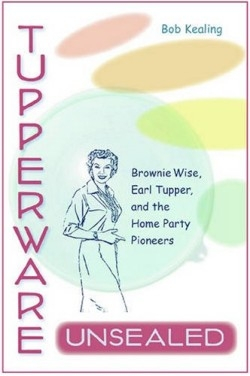Tupperware Unsealed
Brownie Wise, Earl Tupper, and the Home Party Pioneers
Kathleen Bellow scurried up the stairs with her eight-month-old son, Hayden, as Hurricane Katrina raged. Kathleen’s husband, Frank, was already in the Boston Whaler alongside the submerging house. Kathleen looked down the steeply pitched roof to the sloshing boat wondering how she could get her son to safety. Quick thinking made her reach for a Tupperware clothes bin. She gently placed little Hayden inside, sealed the top, and let it slide down and over the slippery roof to be caught by her husband. And so another use of Tupperware was discovered, the miracle container born in 1947.
Earl Silas Tupper (1907-1983), a farmer’s son and tinkerer, went to work for a DuPont plastics subsidiary in 1937. He stayed one year and then formed his own plastics engineering company. After WWII he was looking for a less brittle material for non-military use. He found it in flexible polyethylene. Tupper thought he could use it to stretch the life of kitchen leftovers. Finding a lid was the problem; the answer came after examining a paint can lid. Testing the product revealed its superior durability, for example, inmates at a Massachusetts asylum could only damage the product by chewing it. His inspiration led to the “wonder bowl,” with its “burping” lid to expel air. Even though the invention was a success, store sales proved difficult.
In 1951 he met Brownie Wise (1913-1992), a successful home party saleswoman for Stanley Home Products. She became his vice president and general manager. Leading the company to a fever pitch of sales through home parties, she became known as The Queen. She was the first woman to be on the cover of Business Week. Her genius was intuitive marketing, mink coat-motivation, and party-planner recognition. In 1958 Wise produced more orders than the factory could manufacture, but was abruptly let go.
Kealing begins with the mystery of Wise’s impending firing, but stops there and backtracks with biographies of Tupper and Wise, how they joined forces, and the history of the product and company. Near the end of the book he takes up the execution. The author’s surprise selection of details such as Wise’s thirty-foot desk with peacock wicker chair and the 1957 sales convention armada gone awry on Isla Milagras makes the story fresh.
In 1958 Earl Tupper sold his “rubber dish” company to Rexall Drug for sixteen million dollars, divorced his wife, and bought an island.
Tupperware Unsealed is a management case-study written with the intrigue of a true crime story.
Reviewed by
Alex Moore
Disclosure: This article is not an endorsement, but a review. The publisher of this book provided free copies of the book to have their book reviewed by a professional reviewer. No fee was paid by the publisher for this review. Foreword Reviews only recommends books that we love. Foreword Magazine, Inc. is disclosing this in accordance with the Federal Trade Commission’s 16 CFR, Part 255.

